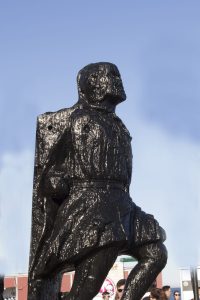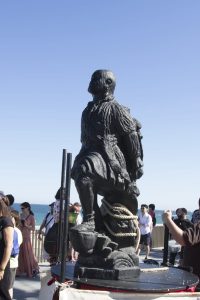
The secret of El Negre de la Riba
Antonio Iturbe
It was in the middle of the 19th century, one of those afternoons when the day was already at an end, when those who were drinking some throat-scorching “barrechas” in one of the stalls open on the slope of the wall in front of the quay, which they called “pudas” because of the rotten stench they emitted, saw an unbound brigantine arrive, very old, looking as if it wanted to die. The owner of the brig, Francesc Bonjoch, was struck by the fact that the figurehead was the one of a man who looked so black that he seemed to be singed. He became infatuated with the figure, which must have come from the Congo at least, and before the ship was scrapped, he bought it to decorate his premises.

The fishermen and the port workers, upon entering, greeted El Negre de la Riba and, after the third barrel of brandy, they would talk to him as if he were a member of the family. When they closed the pude, the figure travelled to a Bonjoch cellar near the Plaza del Torín so that he would go with the bulls that jumped into the ring and the superstitious bullfighters would touch his feet as if he were Saint Martin de Porres. Over the years, it passed from hand to hand, made its pilgrimage to various places in Barcelona and was finally bought at a bargain price by a businessman from El Carmelo called Moragas, who took it to decorate the courtyard of his house.
In the absence of the figure, the children of the neighbourhood became more unruly than ever which only made the parents desperate, and so the people of Barceloneta, out of sheer homesickness, would go to the mountain of El Carmelo, at the other end of the city, to cling to the fence of the tower and see the Negre de la Riba there. On Sundays, groups were organised to go and visit him like those who go to visit their grandmothers.
When Moragas died, his nephews gave the statue to the Barcelona Maritime Museum in 1934, so that it could be kept with other figureheads in the archives there. It was at the museum, where the restorers said that the Barceloneta people had been wrong for half their lives: that the figure was coloured and had been blackened by bad life, and that it was not a black African but an American Indian. It didn’t matter: the biggest tragic losers of history are all black people, whatever their skin tone.
In 2003, on the 250th anniversary of the founding of Barceloneta, a request was made for the Negre de la Riba to return to the neighbourhood. The City Council had a reproduction of the figure of the Negre de la Riba made, and hung it on the wall at the end of Carrer Alegria so that it could be taken down and carried from one side to the other, like a Virgin in procession, during the festivities
But there is something that the Maritime Museum does not know, and I beg all those who read these essential lines to keep it a secret. I won’t name names, but there are people in the neighbourhood who know a lot about underground plans and the labyrinth of galleries beneath the ground. One night, some people in the neighbourhood discreetly took down the reproduction of the Negre, wrapped it in a chequered blanket and went to a cellar where there is a trapdoor leading down into the tunnels where even rats get lost.
 Carrying the Negre, they crossed the Paseo de Colón underneath like moles. It was difficult to enter the museum through the basement where they keep the remains of unnamed ships and to lift the figure, but two of them were old-fashioned dockers and had arms like hams. In the silence of the museum, they went down to the real Negre de la Riba and made the switch with the copy. When they arrived with the Negre in the neighbourhood it was early in the morning and a few people were waiting for them. Together, they lifted the Negre up, without any noise or fuss, with an Easter respect. They took out a few bottles of good brandy and, without making too much noise, they made a toast as the sun was about to rise, because the Negre de la Riba had returned home.
Carrying the Negre, they crossed the Paseo de Colón underneath like moles. It was difficult to enter the museum through the basement where they keep the remains of unnamed ships and to lift the figure, but two of them were old-fashioned dockers and had arms like hams. In the silence of the museum, they went down to the real Negre de la Riba and made the switch with the copy. When they arrived with the Negre in the neighbourhood it was early in the morning and a few people were waiting for them. Together, they lifted the Negre up, without any noise or fuss, with an Easter respect. They took out a few bottles of good brandy and, without making too much noise, they made a toast as the sun was about to rise, because the Negre de la Riba had returned home.
